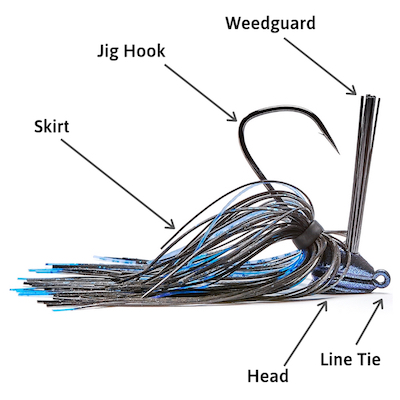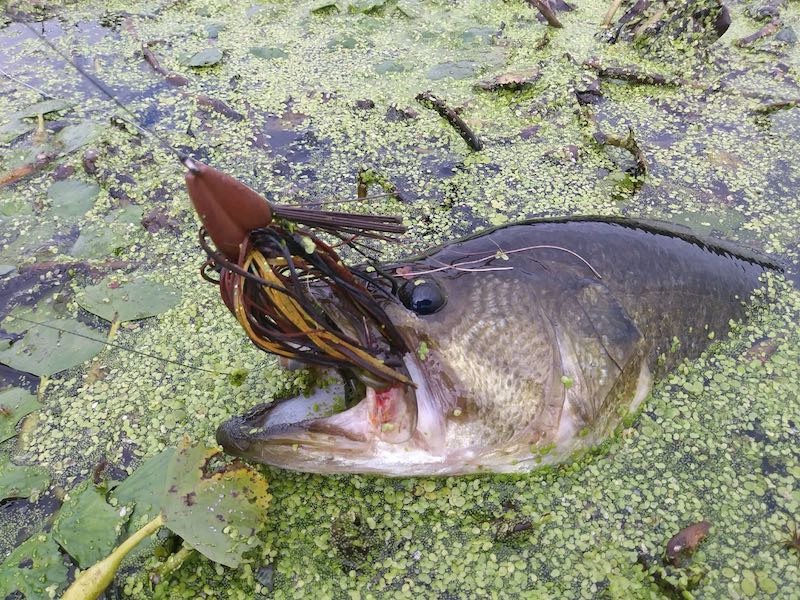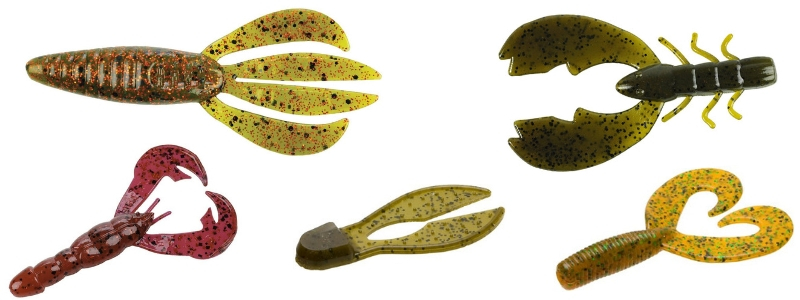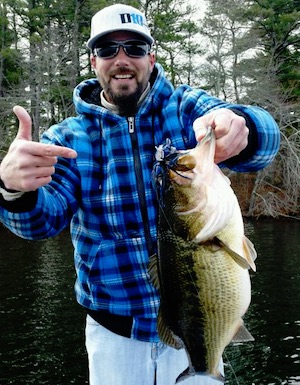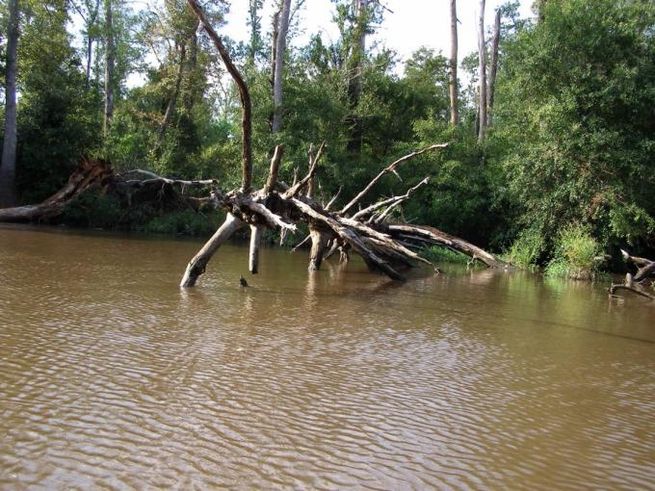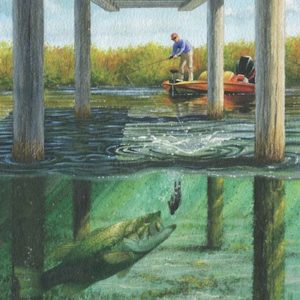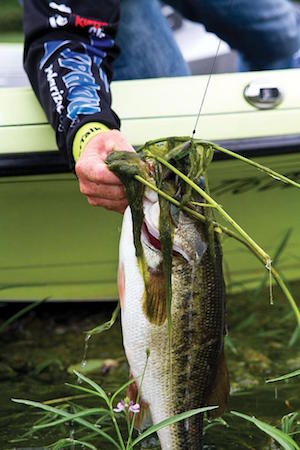
Jig fishing can be one of the most rewarding forms of bass fishing there is. This is because jigs entice big bass to bite, more so than most other bass fishing lures.
Fishermen of any skill level can find success jig fishing, but jigs are a difficult lure to fully master. You won’t become an expert overnight, but once you get a feel for fishing jigs it will be hard to stop throwing them.
Bass jigs are also highly effective year-round and can be fished just about anywhere on a body of water. Between that and being a big bass magnet, bass jigs are arguably the best and most versatile lure for bass fishing.
Contents
Top Rated Bass Jigs
This page goes over all the different types of bass jigs and tips on how to jig for bass. But if you’re just looking for the best bass jigs then we recommend BiCO Performance Jigs.
All BiCO Jigs are made lead-free in the USA with Owner hooks. Too many people underestimate the importance of having a quality hook on a jig, and it’s tough to beat Owner.
Types of Bass Jigs
The basic makeup of any bass jig is simply a hook with a metal head at the line tie. They are then equipped with a rubber skirt and weedguard positioned in front of the hook to prevent snagging.
Certain types of bass jigs excel in different jig fishing scenarios. For the most part what makes one bass jig different from another is the size and shape of the head. These two attributes affect how the jig performs in the water, and of course the weight of the jig.
There are five styles that make up the most popular jigs for bass fishing. Let’s take a closer look at them and where they excel.
1. Arkie Jigs
The most commonly used bass jigs are Arkie jigs, also referred to as flipping or casting jigs.
These are your “all-purpose” jigs, well-suited to cover the majority of jig fishing techniques. If you’re just starting out, or only going to throw one type of jig, then this is the one you want.
Arkie jig heads are wide enough to give them good balance when sitting on the bottom, but slim enough to come through weeds well. This makes them ideal for flipping and pitching in to vegetation. But also versatile enough that you could use them as a swim jig too.
These are the best types of jigs if you’re fishing a lake that has a bunch of different cover. They give you the flexibility to to mix up your presentation along the way.
Whether you’re swimming them along docks or weed edges, or lettinging them sink down into some deep brush or rock, these jigs have got you covered.
2. Football Jigs
These heads are, you guessed it, shaped like a football. The shape of the head on a football jig makes them wobble as they sink. The same is true as they’re being dragged along the bottom.
This wide-shaped head also gives it tremendous balance. This keeps the bait standing upright, for a better presentation while keeping the hook from getting snagged on the bottom.
This attribute makes football jigs the best type of jig for fishing rock and hard bottoms. Their stability makes them less likely to get hung up in the rocks the way a jig laying on its side would.
The best way to fish a football jig is to drag or hop it along the rocks. This is a great way of mimicking a crayfish. However, the wide head makes them less than ideal for jigging in vegetation.
3. Swim Jigs
The heads on swim jigs have a slimmer profile, that come to a point where the line tie is. This allows them to cut through water and vegetation better than other types of jigs that typically have more of a rounded head.
Swim jigs are most often paired with some type of paddle tail jig trailer, which gives a swim jig a nice side-to-side tail kicking action. Unlike with most bass jigs, which are for the most part designed to mimic a crayfish, swim jigs are made to look like a swimming baitfish.
The most common way to fish a swim jig is by continuously reeling it in, the way you would work a spinnerbait. However, letting it sink or giving the rod a random jerk periodically can trigger a bite if the straight retrieve isn’t getting results.
Swim jigs are the ideal style of jig for power fishing in and around cover. You can cover a lot of water without getting hung up like you would with most power fishing lures.
- For more information visit the Swim Jigs page.
- Also see Bladed Swim Jigs.
4. Finesse Jigs
Although similar in appearance, finesse jigs are smaller in size and designed for much lighter tackle. In most cases, the skirt is cut shorter around the head so the strands flare up around it.
These jigs are designed for a style of fishing called finesse fishing. This is a technique where you fish slowly with small baits with light tackle.
Finesse jigs are ideal for flipping around light cover, in clear water with hard or sandy bottoms. This is why they are one of the best smallmouth lures. Like with all finesse lures, these jigs are great for when conditions get tough and bass don’t seem to be biting anything.
- For more information visit the Finesse Jigs page.
5. Punch Jigs
A punch jig is a type of punching rig, that has a bullet-shaped head designed for plunging through thick vegetation.
These jigs are strictly designed for this style of fishing, and require a heavy duty punching rod. Not only to handle the heavier weight of these jigs, but also to pull bass out of the thick cover that these jigs can get in to.
Punching jigs are made heavier than most bass jigs. They will typically weigh in the range of around three quarters of an ounce to as much as two ounces. They need to be this heavy to plunge through anything in their way and get to the bottom.
Ideally you want to tie on the lightest jig possible, while still being able to get through the weeds efficiently. The photo above is of the BiCO Bomb, a really unique one ounce punch jig.
Here is an informative video of the creator of this bait flipping it in to some thick vegetation. He also recently created a half-ounce version of the jig called the BiCO Bullet, designed for lighter vegetation.
Selecting The Best Bass Jigs
Now that you know the different styles of jigs you now need to determine what weight to go with. Bass jigs are made in a range of weights that are measured in ounces, mostly in fractions of an ounce.
There are two main factors you need to consider, the depth you are targeting and the current wind speed. These two factors will directly affect the sink rate of your jig. As well as how well you are able to keep the jig in the zone you want it in.
Depth Factor
The most frequently used weight for a bass jig is three-eighths of an ounce. This is the perfect weight for fishing in shallow water (one to six feet), on a relatively calm day.
Once you start getting in to water ten feet or deeper, it takes a long time for a three-eighths ounce jig to get to the bottom. This is when increasing the weight to half an ounce can make a huge difference.
It doesn’t seem like a huge difference in weight, but if you start adding up the extra sink time wasted on a full day of fishing, it’s surprising how much more water you can cover with the appropriate jig weight.
Wind Factor
Wind speed can also have a major effect on jig fishing. In general heavier winds call for heavier jigs. If the wind is blowing your line and not allowing the jig to maintain contact with the bottom or sink at a good rate, then the jig is too light.
The jig should be heavy enough so the line can overpower the wind and get the jig to the bottom. But you never want your jig to be heavier than it needs to be.
The heavier a jig is, the less natural is feels to a bass when in its mouth. This can cause a bass to spit it out quicker than if it felt lighter. Like closer to the weight of a natural crawfish for example.
Selecting A Trailer
You never fish a bass jig without some type of a trailer attached. A jig trailer is a soft plastic bait that get rigged on the hook of the jig. It adds action to the tail end of the jig and completes the overall profile of the bait.
The endless variety of trailer styles and sizes allows you to customize a jig to suit the exact presentation you want to achieve. Some popular types of jig trailers are ribbon tails, craws, and paddle tails.
The biggest difference from one trailer to the next is the action they put out. Some trailers have a ton of action while some have no action at all. It all depends on what kind of presentation you are looking for.
As a general rule of thumb, the warmer or murkier the water the more action you want. And the clearer or colder the water is the less action you want.
You can combine just about any jig trailer with any jig. But for a swim jig or bladed jig it is more common to see a paddle tail trailer used. This gives the jig a side-to-side, tail kicking action that a swimming baitfish would have. Rather than the up and down flapping motion most other jig trailers have.
- For more information visit the Jig Trailers page.
Jig Fishing For Bass
Probably the most appealing thing about bass jigs is how effective they are all year long. From freezing cold water temps to hot summer conditions, these lures continue to produce at a high level.
Of course as the seasons change you need to make adjustments. Things like where you fish them, style selection, and tweaks in presentation with vary throughout the year.
But no matter what time of year it is, when you’re jig fishing for bass it’s all about the bottom and how you relate to it.
It’s about how you get there, how fast you get there, and how you interact with it.
Detecting Bites
Jig fishing requires patience and attention to detail the entire time your jig is in the water. There are two ways you’re going to know if you have a bite, by seeing the line move or feeling it in the rod handle.
This is why you need to be constantly watching your line and trying to feel and identify different vibrations. At first you may have a difficult time telling the difference between a bite and hitting something underwater.
Feel and sensitivity is so important in jig fishing. So you need to be using a good jig rod to detect the sometimes subtle vibrations traveling from the jig to the butt of the rod handle.
And keep your line tight! The best jigging rod in the world is not going to make up for having too much slack in your line.
The Bite
But even with a tight line, a bass hitting a jig can be a tough bite to detect. A bass will eat a jig in one of two ways, by picking it up off the bottom or engulfing it while it’s sinking.
The bite will usually feel like a light thump that travels up the line or the rod will suddenly feel weightless. Some bites are more aggressive than others and it’s the subtle ones that you need to be on high alert for.
But however the bite feels, you need to respond immediately by setting the hook.
Setting The Hook
Setting the hook properly is an essential part of jig fishing for bass. Without a proper and timely hookset you are simply not going to catch fish with a jig.
Once a bass picks up your jig, you have a short window of time to quickly pull the rod towards you to bury the hook point past the weedguard and into the fish’s mouth.
You may be setting the hook on every little bump you feel when you’re first starting out. But that’s fine, it’s better to swing on nothing than miss out on a real bite. Over time you will be able to tell the difference between a real bite and making contact with underwater objects.
This makes jigs great for exploring the bottom of a lake. You can use them to feel the difference between different types of underwater cover, where bass are usually holding.
Fishing Cover
Jigs are ideal for targeting all types of cover because of how weedless they are. You can cast them just about anywhere without getting hung up. This gives you a great advantage because you are able to put a jig in front of bass that you wouldn’t be able to with most other lures.
Bass jigs have a flexible weedguard positioned in front of the hook that makes them weedless. The weedguard deflects weeds and other objects as it travels through the water.
Weedguards come in different levels of stiffness so make sure it is plenty stiff, especially if you’re throwing the bait in to heavy cover. You can gauge the stiffness by lightly running your thumb along the weedguard and seeing how much pressure it takes to expose the hook. You don’t want the hookpoint easily exposed or it’s pointless.
One really great target for a jig is a laydown, which is a bass fishing term for a tree laying in the water. Casting a jig into a laydown gives you an opportunity to catch fish that most other lures can’t.
A lot of times the jig will get eaten as it slowly sinks down between the branches of the laydown. But if it doesn’t you want to slowly drag and hop it through the limbs. There is a really good chance of triggering a strike during a retrieve like this, that’s why having a stiff weedguard is so important.
Skipping Jigs
Skipping is another way to get in these hard-to-reach areas. Two great areas to skip under are boat docks and low-hanging trees.
There’s a huge advantage to getting a jig to sink down right in front of a bass that’s sitting under a dock. As opposed to casting out in front of the dock and trying to draw the bass out.
Although it takes a lot of practice, jigs are one of the best lures for skipping. When you start getting good you can really get a jig to skip long distances. Especially if the water is calm, the flatter the surface the further you will be able to skip a jig.
Flipping and Pitching
Flipping and pitching is a very popular jig fishing technique. It involves making accurate, underhand casts that allow the jig to enter the water quietly.
This is close-quarters fishing. You’re only flipping the jig out ten or twenty feet, so a silent entry is key for not spooking the fish.
This method is ideal when you’re targeting visible cover like weed edges, boat docks, timber, or big rocks emerging from the surface. The advantage is being able to enter an area loaded with cover and flip your jig to multiple spots quickly and efficiently.
How To Flip & Pitch
All you do is flip or pitch the jig to the spot you are targeting and let it sink. If you get a strike, it will usually happen during the fall or soon after it hits the bottom. Once on the bottom, pop it up a one or two times to see if you can trigger a strike. If you don’t get a bit then reel it in and repeat the process.
Because you are most likely to trigger a reaction bite on the initial fall it’s important to have good accuracy. If you miss your target even by a foot or two, you’re giving the bass holding to that cover too much distance to investigate the jig. You want the jig to fall right next to it so the bass doesn’t even have time to think and will just react by biting.
If you’ve never tried flipping and pitching, then you should work on your accuracy as much as possible. You can even do this in your backyard by tossing the jig at targets set at various distances.
Punching Jigs
You may have heard advanced bass anglers talk about punching mats. In bass fishing, the term “punching” means dropping your bait in to thick vegetation in order to plunge the jig through to the bottom.
During the hot summer months, bass bury themselves under thick weed mats to keep out of the sun and stay cool. The good news is you know where to target the fish if you can find some good matted vegetation.
The bad news is it can be difficult to horse the fish out of there. This style of fishing requires an adequate punching rod rigged with heavy duty line for pulling the fish out.
Not only do the heavy weeds provide cooler water, they are also home to a lot of forage. For example, crayfish will dart down from the weeds to get to the bottom and bass will pluck them off all day. When you punch a jig thought the weeds you are imitating that action.
- For more information visit the Punch Rigs page.




